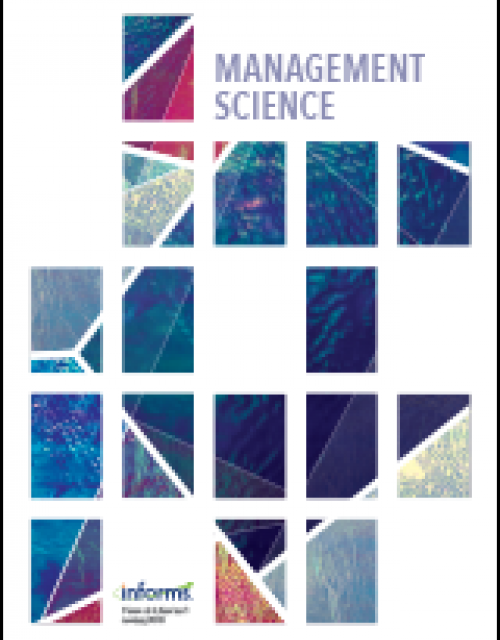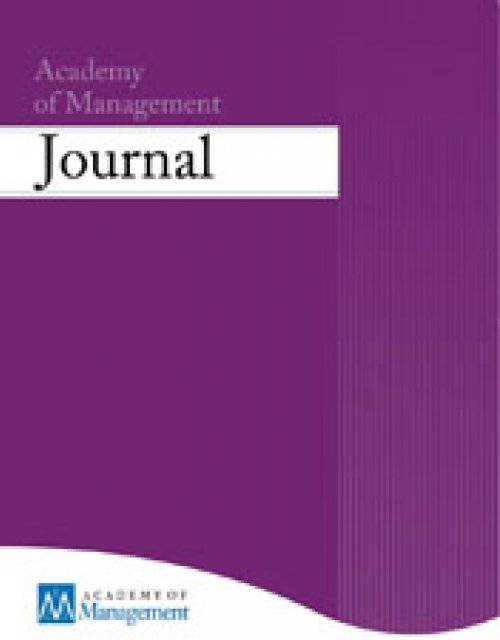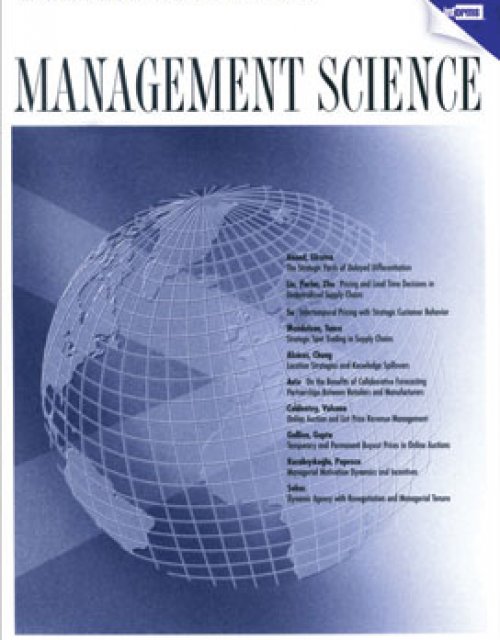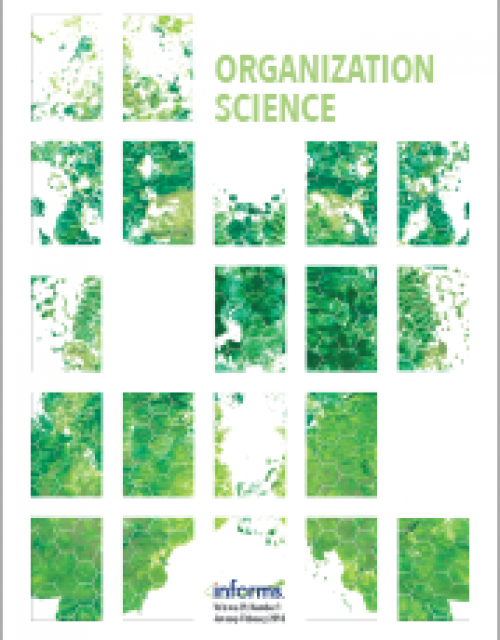Publication records
Subject(s)
Diversity and inclusion; Health and environment; Technology, R&D management
Keyword(s)
open Innovation in Science (OIS), open science, citizen science, crowd science, crowd paradigms
Volume
9
Journal Pages
1–12
ISSN (Online)
2057-4991
Subject(s)
Strategy and general management; Technology, R&D management
Keyword(s)
novelty, innovation, selection, simmelian strangers, secondments
Volume
45
Journal Pages
716–744
Subject(s)
Human resources management/organizational behavior
Keyword(s)
leadership, leadership transitions, career transitions
ISSN (Print)
0015-6914
Subject(s)
Health and environment; Information technology and systems; Technology, R&D management
Keyword(s)
crowd science, citizen science, crowdsourcing, organizational design, research productivity, societal impact, research policy
Secondary Title
Oxford Research Encyclopedias: Business and Management
ISBN (Online)
9780190224851
Subject(s)
Management sciences, decision sciences and quantitative methods
Keyword(s)
reproducibility, replication, crowd science
With the help of more than 700 reviewers, we assess the reproducibility of nearly 500 articles published in the journal Management Science before and after the introduction of a new Data and Code Disclosure policy in 2019. When considering only articles for which data accessibility and hardware and software requirements were not an obstacle for reviewers, the results of more than 95% of articles under the new disclosure policy could be fully or largely computationally reproduced. However, for 29% of articles, at least part of the data set was not accessible to the reviewer. Considering all articles in our sample reduces the share of reproduced articles to 68%. These figures represent a significant increase compared with the period before the introduction of the disclosure policy, where only 12% of articles voluntarily provided replication materials, of which 55% could be (largely) reproduced. Substantial heterogeneity in reproducibility rates across different fields is mainly driven by differences in data set accessibility. Other reasons for unsuccessful reproduction attempts include missing code, unresolvable code errors, weak or missing documentation, and software and hardware requirements and code complexity. Our findings highlight the importance of journal code and data disclosure policies and suggest potential avenues for enhancing their effectiveness.
© 2024, INFORMS
Volume
70
Journal Pages
1343–1356
ISSN (Online)
1526-5501
ISSN (Print)
0025–1909
Subject(s)
Diversity and inclusion
Keyword(s)
workplace visibility, career development, self-promotion, emotional barriers, societal norms, professional growth, networking strategies, gender expectations, personal branding, collective responsibility, behavioral change, head heart and hands
ISSN (Print)
0015-6914
Subject(s)
Strategy and general management; Technology, R&D management
Keyword(s)
open Innovation in science, scientific knowledge production, co-creation, crowd science, citizen science, university-industry collaboration, interdisciplinary research, transdisciplinary research, stakeholder engagement
JEL Code(s)
O36
Secondary Title
The Oxford handbook of open innovation
Pages
455–472
Subject(s)
Strategy and general management; Technology, R&D management
Keyword(s)
search, external search, ideas, crowdsourcing, co-evolutionary lock-in, attention
While external search allows organizations to source diverse ideas from people outside the organization, it often generates a narrow set of non-diverse ideas. We theorize that this result stems from an interplay between organizations’ selection of ideas and the external generation of ideas: an organization selects ideas shared by external contributors, and the external contributors, who strive to see their ideas selected, use the prior selection as a signal to infer what kind of ideas the organization is looking for. Contributors whose ideas are not aligned with the organization’s selection tend to stop submitting ideas (i.e., self-selection) or adjust the ideas they submit so that they correspond (i.e., self-adjustment), resulting in a less diverse pool of ideas. Our central hypothesis is that the more consistent organizations are in their selection, the stronger the co-evolutionary lock-in: organizations with greater selection consistency receive future ideas with lower content variety. We find support for these predictions by combining large-scale network analysis and natural language processing across a large number of organizations that use crowdsourcing. Our findings suggest a reconceptualization of external search: organizations are not simply passive receivers of ideas but send signals that shape the pool of ideas that externals share.
With permission of the Academy of Management
Volume
67
Journal Pages
262–288
Subject(s)
Management sciences, decision sciences and quantitative methods; Product and operations management; Technology, R&D management
Keyword(s)
Machine-learning, rational inattention, human-machine collaboration, cognitive effort
The rapid adoption of AI technologies by many organizations has recently raised concerns that AI may eventually replace humans in certain tasks. In fact, when used in collaboration, machines can significantly enhance the complementary strengths of humans. Indeed, because of their immense computing power, machines can perform specific tasks with incredible accuracy. In contrast, human decision-makers (DM) are flexible and adaptive but constrained by their limited cognitive capacity. This paper investigates how machine-based predictions may affect the decision process and outcomes of a human DM. We study the impact of these predictions on decision accuracy, the propensity and nature of decision errors as well as the DM's cognitive efforts. To account for both flexibility and limited cognitive capacity, we model the human decision-making process in a rational inattention framework. In this setup, the machine provides the DM with accurate but sometimes incomplete information at no cognitive cost. We fully characterize the impact of machine input on the human decision process in this framework. We show that machine input always improves the overall accuracy of human decisions, but may nonetheless increase the propensity of certain types of errors (such as false positives). The machine can also induce the human to exert more cognitive efforts, even though its input is highly accurate. Interestingly, this happens when the DM is most cognitively constrained, for instance, because of time pressure or multitasking. Synthesizing these results, we pinpoint the decision environments in which human-machine collaboration is likely to be most beneficial.
© 2023, INFORMS
Volume
70
Journal Pages
1258–1275
ISSN (Online)
1526-5501
ISSN (Print)
0025–1909
Subject(s)
Human resources management/organizational behavior
Keyword(s)
structural holes, brokering behaviors, tertius separans, tertius iungens, social networks
Connecting otherwise disconnected individuals and groups - spanning structural holes - can earn social network brokers faster promotions, higher remuneration, and enhanced creativity. Organizations also benefit through improved communication and coordination from these connections between knowledge silos. Neglected in prior research, however, has been theory and evidence concerning the psychological costs to individuals of engaging in brokering activities. We build new theory concerning the extent to which keeping people separated (i.e., tertius separans brokering) relative to bringing people together (i.e., tertius iungens brokering) results in burnout and in abusive behavior toward coworkers. Engagement in tertius separans brokering, relative to tertius iungens brokering, we suggest, burdens people with onerous demands while limiting access to resources necessary to recover. Across three studies, we find that tertius separans leads to abusive behavior of others, mediated by an increased experience of burnout on the part of the broker. First, we conducted a five-month field study of burnout and abusive behavior, with brokering assessed via e-mail exchanges among 1,536 university employees in South America. Second, we examined time-separated data on self-reported brokering behaviors, burnout, and coworker abuse among 242 employees of U.S. organizations. Third, we experimentally investigated the effects of the two types of brokering behaviors on burnout and abusive behavior for 273 employed adults. The results across three studies showed that tertius separans brokering puts the broker at an increased risk of burnout and subsequent abusive behavior toward others in the workplace.
© 2023, INFORMS
Volume
35
Journal Pages
177–194



